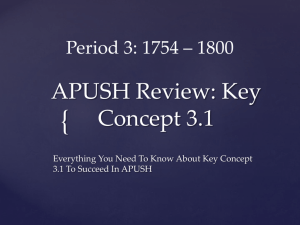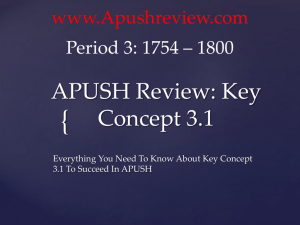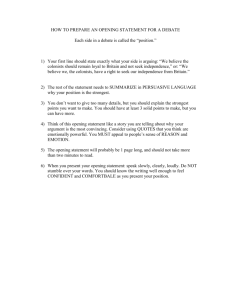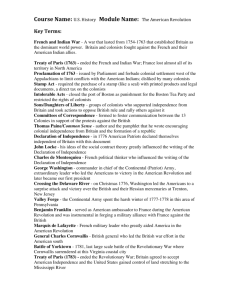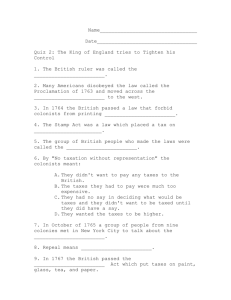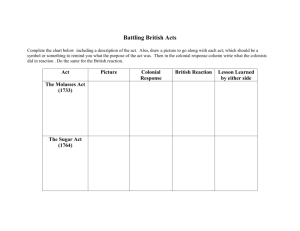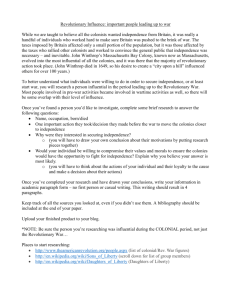Key Concept Notes for Period 3
advertisement
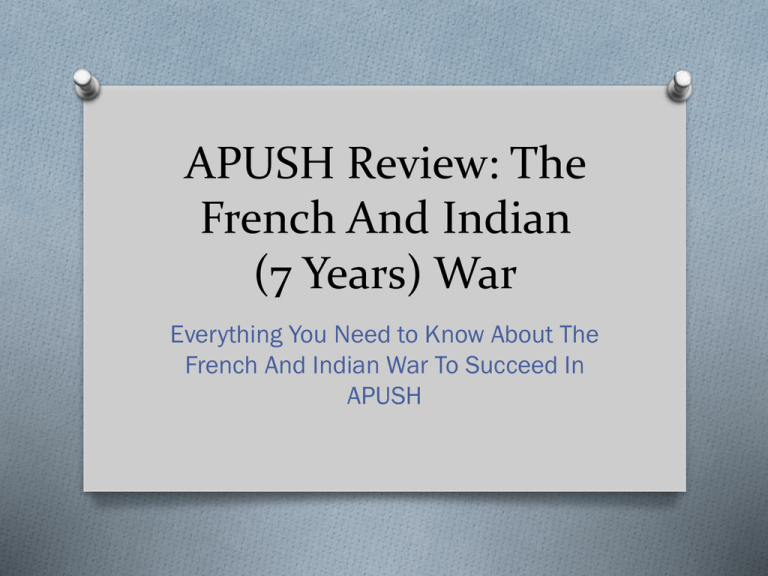
APUSH Review: The
French And Indian
(7 Years) War
Everything You Need to Know About The
French And Indian War To Succeed In
APUSH
Key Ideas Before the War
O Albany Plan of Union(1754):
O Purpose was to negotiate a treaty between Iroquois
and the British
O Significance:
O “Join or Die”
O COLONIAL UNITY!!!
O Did it pass?
O Delegates of convention passed it, colonies and Britain
rejected it. Why?
O Increase taxes by colonists
O Colonies didn’t want to surrender control
O Salutary Neglect:
O Britain left colonies develop on their own, so long as
they were profitable
The War
O Causes:
O Started in 1754
O George Washington sent to challenge French
expansion
O Lasted from 1754 - 1763
O The F & I War was part of a larger conflict, 7
Years War
O Most Natives (except Iroquois) sided with the
French
O British forcibly enlisted colonists and forced
colonists to provide shelter
Peace of Paris, 1763
O Britain gained all French land east of
Mississippi River, except New Orleans
O French gave New Orleans and land west of
Mississippi to the Spanish
O England and Spain swap Cuba/Florida
Big Ideas After the War
O Balance of Power shifts in North America
O Native Americans lose a partner in France
O Tensions increase between Britain and
colonists
O Britain feels the colonies should share in the
responsibility of the empire
O The colonists will wish to go back to Salutary
Neglect
Political Impacts of the War
O Salutary Neglect ENDS!
O Britain now takes a hands on approach to governing
colonies
O King George III and new PM George Grenville
O Proclamation Line of 1763
O Hoped to avoid conflict between colonists and Natives
O British troops were stationed on the border
O Colonists resent not being allowed to expand
O Colonial Resistance to the British Policies
O Sons of Liberty
O Smuggling
O Writs of Assistance, Admirality Courts
Economic Impacts of the War
O Britain is in debt
O Colonists contributed little financially, Britain began
to tax the colonists and strictly enforce those taxes
O End of salutary neglect
O Currency Act
O Stamp Act
O Stamp Act Congress
O Boycotting of British Goods
O Declaratory Act
O “No Taxation Without Representation”
Social Impacts of War
O Colonial soldiers viewed themselves as equals
with British soldiers, not vice versa
O British viewed colonial soldiers as inadequate
O George Washington only promoted so far
O Emergence of a colonial identity
O Colonial Unity AGAINST the British
O Stamp Act Congress
Past Essay Topics
O 2004 DBQ: In what ways did the French and
Indian War (1754-63) alter the political,
economic and ideological relations between
Britain and its American colonies?
O 2012 Free Response: Analyze the effect of
the French and Indian War and its aftermath
on the relationship between Great Britain
and the British colonies. Confine your
response to the period from 1754 to 1776
Day 2 (One Day)
O By the way if you keep all our
notes for the class, you can
use that as a nice Bonus
grade in 4th Quarter.
Period 3: 1754 – 1800
APUSH Review:
{ Key Concept 3.1
Everything You Need To Know About Key Concept
3.1 To Succeed In APUSH
The New Curriculum
Key Concept 3.1 “Britain’s victory over France in the imperial
struggle for North America led to new conflicts among the British
government, the North American colonists, and American Indians,
culminating in the creation of a new nation, the United States.”
Page 32of the Curriculum Framework
Big ideas:
How did Native Americans’ relationship with the colonists change after
the 7 Years War?
What led to Britain ending salutary neglect? Why and how did
colonists resist this?
What were the US’ foreign policy goals post-independence?
Key Concept 3.1, I
“‘Throughout the second half of the 18th century, various American
Indian groups repeatedly evaluated and adjusted their alliances with
Europeans, other tribes, and the new United States government.” - Page
32 of the Curriculum Framework
As the English colonists expanded into the interior (Ohio River
Valley,) conflicts emerged
French and Indian War (7 Years War) – Britain and colonists versus
the French and Natives
Iroquois allied with the British
Native life changed drastically after the war
The French were removed from North America – lost a trading
partner
British colonists expanded on to native land
Pontiac’s Rebellion -> Proclamation Line of 1763
The Aftermath: Tensions
Along the Frontier
1763 Pontiac’s Rebellion
Fort Detroit
British “gifts” of smallpox-infected
blankets from Fort Pitt.
Pontiac’s Rebellion (1763)
BACKLASH!
British Proclamation
Line of 1763.
Colonials Paxton Boys (PA)
Attacked Susquehannock, then Phildelphia
Key Concept 3.1, I Cont.
During the Revolutionary War, some natives sided with the
British:
3 of the 6 Iroquois Confederacy supported the British
The Oneida and Tuscarora sided with the Americans
Years after the war (1795), natives ceded land under the Treaty
of Greenville
In return, natives received an acknowledgement of their claim to
certain territory
Key Concept 3.1, II
“During and after the imperial struggles of the mid-18th century, new
pressures began to unite the British colonies against perceived and real
constraints on their economic activities and political rights, sparking a
colonial independence movement and war with Britain.” - Page 33 of the
Curriculum Framework
Debt from the 7 Years’ War helped lead to the end of Salutary
Neglect:
Britain tightened its control over markets, taxes, and colonial
government – many colonists resisted this new policy
Stamp Act Congress (1765) – colonial response to Stamp Act, tarred
and feathered tax collectors; Stamp Act was repealed
Committees of Correspondence (1770s) – spreading of info and
propaganda about British policies
Intolerable Acts (1774) – passed in response to the Boston Tea Party;
shut down the port of Boston until damages were paid
Key Concept 3.1, II Cont.
Individuals involved in the independence movement:
Elites: Paul Revere and John Hancock – wealthy merchants that protested
taxation
Grassroots movements:, Mercy Otis Warren – writer that urged
independence
Arguments for independence:
Rights of British subjects:
Rights of individuals:
Taxation, writs of assistance, admirality courts
Enlightenment ideas:
Rejection of “virtual representation” – idea that Parliament acted in best
interest of all British subjects
Consent of the governed
“Life, liberty, and property”
How did colonists win?
Familiarity with the land, military leadership (Washington, Arnold), deep
commitment to their cause, and foreign aid – most notably the French,
after Saratoga
Key Concept 3.1, III
“In Response to domestic and international tensions, the new United
States debated and formulated foreign policy initiatives and asserted an
international presence.” - Page 33 of the Curriculum Framework
After the Revolutionary War, European countries still posed
challenges to the US
America remained neutral in war between British and French
following the French Revolution
British seized American ships trading with French
England still had a strong presence in North America, and even
America
Did not abandon some posts (forts), such as Fort Niagara, as promised
in the Treaty of Paris of 1783
Key Concept 3.1, IIIBeware
Cont.
of
FrenchViva
Revolution
La
Influenced
by American Revolution and Enlightenment ideas
France!
US remained neutral in conflict between France and Britain
Washington’s Farewell Address:
foreign
alliances and
political parties
Warned of permanent alliances and dangers of political parties
After Washington’s presidency, conflict between Britain and
France helped lead to partisan debates in the 1790s
Democratic-Republicans (Jeffersonians) tended to support the
French
Federalists (led by Hamilton) tended to support the British
Test Tips
Multiple-Choice and Short Answer Questions:
Wars and their impacts on Native Americans (7 Years and
Revolutionary Wars)
Washington’s Farewell Address
Impact of the 7 Years War (End of salutary neglect)
Challenges faced post-independence
Essay Questions:
Political, social, and economic causes of the Revolutionary War
How can the French And Indian War be seen as a turning point in
American History?
APUSH REVIEW: THOMAS
PAINE’S COMMON SENSE
Everything You Need To Know About Thomas
Paine’s Common Sense To Succeed In
APUSH
The New Curriculum And Common Sense
• Key Concept 3.2, I, B: “The colonists’ belief in the
superiority of republican self-government based on the
natural rights of the people found its clearest American
expression in Thomas Paine’s Common Sense and in the
Declaration of Independence.”
• Page 34 of the Curriculum framework
• Common Sense played an intricate role in influencing the
colonists’ decision to declare independence
• Since it is mentioned specifically, you should be very familiar with it
Events Prior to Common Sense (January
1776)
• 1775:
• April – Battles of Lexington and Concord
• July – Olive Branch Petition – colonists hoped to have peace
and grievances addressed, rejected by KG3
• Throughout 1775 and the early part of 1776, most
colonists did NOT want independence
• Rather, they were seeking a redress of grievances and to go
back to the days of salutary neglect
Enter T-Paine
• Who was he?
• Philosopher from England that moved to America in 1774
• Ideas reflected the Enlightenment
• Why did he publish Common Sense?
• He urged America to break away from Britain and KG3
The Message and Impact
•
You get a
Sense!
You4getsections
a
The book was divided Common
into
You get a
Common
Sense!
You get
a
1. Origins of government andCommon
remarks
on
Constitution
YouSense!
get English
a
Common
YouSense!
get a
Common Sense!
2. Monarchy and Hereditary Succession
Common Sense!
3.
4.
Present state of American affairs
Present ability of America
• It was written to appeal to common people
• Proportionally to the population at the time, it is
the best-selling book in American history
• As many as 500,000 copies to a population of 2.5 million
Test Tips
• Multiple-Choice Short Answer Questions:
• Perhaps an excerpt from the reading: what was the purpose
• Cause of the Revolution
• Essay Questions:
• Part of the influences (causes) of the American Revolution
Day 4 and 5
APUSH Review:
The Revolutionary
War
Everything You Need to Know About The
Revolutionary War To Succeed In APUSH
Events Before the War
• End of Salutary Neglect
• Taxes:
o Sugar 1764, Currency 1764, Quartering 1765, Stamp 1765, Declaratory Act 1766,
Townshend 1767, Tea 1773, Coercive Acts 1774, Quebec Act 1774, etc.
• Representation (lack of)
• Wars?
o
o
o
o
o
King William’s War
Queen Anne’s War
War of Jenkin’s Ear
King George’s War
Seven Years War (French and Indian War)
• Committees of Correspondence
• Sons of Liberty / Tar and Feathering
• Boston Massacre & Boston Tea Party
Effects of the Wars
on Britain?
1. It increased her colonial empire in
the Americas.
2. It greatly enlarged England’s debt.
3. Britain’s contempt for the colonials
created bitter feelings.
Therefore, England felt that a
major reorganization of her
American Empire was necessary!
Effects of the War on the
American Colonials
1. It united them against a
common enemy for the first
time.
2. It created a socializing
experience for all the
colonials who participated.
3. It created bitter feelings
towards the British that
would only intensify.
•Townshend Acts (paper, paint, lead, glass, tea)
1. John Dickinson 1768
* Letters from a Farmer in Pennsylvania.
2. 1768 2nd non-importation movement:
* “Daughters of Liberty”
* spinning bees
3. Riots against customs agents:
* John Hancock’s ship, the Liberty.
* 4000 British troops sent to Boston.
BOSTON TEA PARTY 1773
Key Writings Associated
With The War
• Olive Branch Petition (1775):
o Adopted by 2nd Continental Congress after L and C, and Bunker
(Breed’s) Hill
o Hoped to avoid full-scale war
o Rejected by KGIII
• Shortly after, KGIII hires Hessian soldiers
• Common Sense (1776):
o Written by Thomas Paine (T-Paine!)
o Stated it was “common sense” for America to break away
o Appealed to many Americans “on the fence”
• Declaration of Independence (1776):
o Multiple parts: idea of government; wrongdoings of the King
Patriots and Loyalists
• Patriots:
o Those that favored independence and/or
fought for independence
• Loyalists:
o Americans that stayed loyal to England
o Roughly 20% of the population
o Many were harassed during the war and
had property confiscated
o A significant amount fled to England and/or
Canada after the war
• Traitor?:
o Benedict Arnold
Military Balance Sheet
Key Battles During The
War
• Battle of Bunker (Breed’s) Hill (June,
1775)
o Although the Americans lost, there were heavy British
casualties
o Led to increased morale and belief in military capabilities
• Battle of Saratoga (October, 17, 1777)
o Americans (Gates) defeat the British (Burgoyne)
o This battle results in French aid and an alliance!!!!
• Battle of Yorktown (October, 17, 1781)
o General Cornwallis surrenders to General Washington
o Last major battle of the war
Diplomacy During The
War
• Benjamin Franklin:
o Helped obtain foreign aid, especially French
• Marquis de Lafayette (France):
o Worked at Washington’s side
o Helped with French aid
• February 1788:
o France recognizes US independence
o Soon after, other European countries aid US in the war
Treaty of Paris (1783)
• Officially ends the war
• Terms of the treaty:
o Britain recognized US independence
o Loyalists would not be persecuted
o Americans could fish in Newfoundland
o US gains land east of Mississippi River
o British could collect their debt
Don’t forget about us
WoopsJohn….
Women and the War
• Women’s roles increase while husbands and
fathers fight
o Many women stayed and worked at military camps
• Provide food, caretaking, and laundry
• Some disguised as men to fight
• Impact of the Revolution on Women:
o Abigail Adams’ call to “Remember the Ladies” (1776) is not
successful
o Married women could still not:
• Own property
• Get a divorce
• Vote
o “Republican Motherhood”
• Idea that women should raise virtuous children that are good
citizens
African Americans and
the War
• During the war:
o Roughly 5,000 African-Americans fought on the American
side
o Some slaves fought on the British behalf, or fled to freedom
• Led to resentment from many Southerners
• Impact of the Revolution on AfricanAmericans:
o
o
o
o
“All men are created equal” does not apply
Slavery quickly is abolished in most of north
NW Ordinance (1787) bans slavery in Old NW
Constitution allows for 3/5 Clause and Fugitive Slave Act
Native Americans and the
War
• Iroquois Confederacy was divided over who
to support
o ½ the tribes supported the British
• Challenges for Native Americans after the
war
o England no longer prevented expansion -> Americans moved
west of Appalachian Mountains
o Many Americans resented Natives that fought alongside the
British
Past Essay Topics
• Analyze the political, diplomatic, and
military reasons for the United States victory
in the Revolutionary War. Confine your
answer to the period 1775–1783 (2010)
• Analyze the impact of the American
Revolution on both slavery and the status of
women in the period from 1775 – 1800 (2004)
Period 3: 1754 – 1800
Everything You Need To Know About Key Concept 3.2 To
Succeed In APUSH
The New Curriculum
Key Concept 3.2 “In the late 18th century, new
experiments with democratic ideas and
republican forms of government, as well as other
new religious, economic, and cultural ideas,
challenged traditional imperial systems across the
Atlantic World.”
Page 34 of the Curriculum Framework
Big ideas:
How did Enlightenment ideas help lead to the American
Revolution?
How was the Constitution able to pass in light of
conflicting interests? (North v. South, Federalists v. AntiFederalists)
Key Concept 3.2, I
“During the 18th century, new ideas about politics and society led to
debates about religion and governance, and ultimately inspired
experiments with new government structures.” - Page 34 of the Curriculum Framework
Protestant evangelical religious fervor (1st Great Awakening)
helped promote a new “American” identity
Less of a focus on Anglican Church; 10,000s of colonists converted
Appealed to women and younger sons (those that were not given as
much land as first-born son)
“New Lights” challenged “Old Lights”
“The Enlightenment inspired American political thinkers to emphasize
individual talent over hereditary privilege” – page 34
Similar to the Great Awakening, The Enlightenment challenged traditional
authority
Jean-Jacques Rousseau:
○ Enlightenment thinker that advocated legal and political equality for all, as well
as the end of special privileges for elites
After the Revolutionary War, primogeniture was outlawed in many states
○ Eldest son inherits most, if not all, of property
Key Concept 3.2, I Cont.
Colonial legislatures allowed for a significant amount of selfgoverning, which most colonists held dear
As Britain began to tax more, colonists resisted these acts
They were ok with colonial legislature taxes, NOT Parliament taxes
○ Colonial legislatures were elected by colonists, Parliament was not
Thomas Paine’s Common Sense:
Challenged KG3 – it was “common sense” to break away from the corrupt
monarch
A little island could not rule a larger continent
Declaration of Independence:
Inspired by Enlightenment ideas – John Locke – and Thomas Paine
All men had natural rights of “Life, liberty, and the pursuit of happiness”
Articles of Confederation and state constitutions:
Feared strong centralized power a la Britain
Articles and state constitutions had strong legislative branches
Property requirements for voting and citizenship – fear of the masses
Key Concept 3.2, II
“After experiencing the limitations of the Articles of Confederation, American
political leaders wrote a new Constitution based on the principles of federalism
and separation of powers, crafted a Bill of Rights, and continued their debates
about the proper balance between liberty and order.” - Page 34 of the Curriculum Framework
Challenges under the Articles:
Trade: each state could places tariffs on goods from other states – discouraged trade
between states
Leadership: no real executive, no judicial… couldn’t pass laws without 7 out of 13 for
small rules and 13 out of 13 for amendments.
Finances: each state could coin its own $ - differing values, high inflation in some
states, also discouraged trade
○ Many states had debt from Revolutionary War – increased taxes
○ Federal government could not require taxes… had to ask states for money
Foreign Relations:
○ Britain – refused commercial treaties with US, Congress could not control commerce
(sanctions against Britain)
○ Spain – cut off access to Mississippi River
○ Both countries supplied Native Americans with weapons
○ States could go to war and make alliances with other countries…
Internal unrest:
○ Shays’ Rebellion: - MA farmers demanded debt relief, attacked court houses
These challenges helped many Americans realize a stronger central
government was needed……..
Key Concept 3.2, II Cont.
Compromises at the Constitutional Convention:
Great Compromise (Connecticut Compromise) – Roger Sherman
○ Combined VA Plan (large-states) and NJ Plan (small-states)
○ Created a bicameral legislature with one house based on population (House of Reps)
and one with equal representation (Senate)
○ A census would be taken every ten years to determine population
3/5 Compromise:
○ For the purpose of representation, 3/5 slaves would count as 1 person in the South
BOTH THE GREAT COMPROMISE AND 3/5 COMPROMISE SETTLED THE
ISSUE OF REPRESENTATION
Limits on federal power under constitution:
Federalism – division of power between state and federal governments
○ Specific powers for both the federal and state governments
Republic-A nation in which the supreme power rests upon the people allowed to
vote and is exercised by representatives elected directly or indirectly by them and
responsible to them
Why was the Constitution finally ratified?
Federalists (those that favored the constitution) promised to add a Bill of Rights
that protected liberties
The 1st 10 amendments were added shortly after the Constitution was ratified
Key Concept 3.2, II Cont.
Political parties emerged over the following issues:
Relationship between national government and states – Federalists favored
a stronger national government, Democratic-Republicans favored a smaller gov
○ VA and KY Resolutions – belief that states could nullify federal laws
Economic Policy – Hamilton’s Financial Plan (Federalists) would strengthen the
federal government – the creation of the BUS was NOT mentioned in
Constitution
○ Hamilton argued the Necessary and Proper, or elastic clause
Foreign Affairs – Federalists favored Great Britain – trade and $, Democratic-
Republicans favored France – saw French Rev. as an extension of American
Rev.
Key Concept 3.2, III
“While the new governments continued to limit rights of some groups, ideas
promoting self-government and personal liberty reverberated around the
world.” - Page 35 of the Curriculum Framework
The push for equality after the Revolutionary War:
Some individuals called for the abolition of slavery
○ Pennsylvania’s Gradual Abolition Law (1780):
Prohibited importation of slaves into PA
ALL children born in PA would be free, regardless if their parents were slaves
Model for other northern states to follow
Increased calls for greater political democracy:
○ Abigail Adams’ “Remember the Ladies”
○ Judith Sargent Murray advocated education for females
The Constitutional framers postponed a solution to slavery:
Since slavery was allowed under the Constitution, it led to conflicts in the
19th century, and ultimately, the Civil War
Influence of the American Revolution and Declaration of
Independence?
Inspired revolutions across the world
○ French Revolution in 1789
○ Haiti – Toussaint L’Ouverture helped Haiti gain independence in 1804
○ Latin America – many Spanish colonies gained independence in the early 19th
century
The Paris Monster
William
Duane
In February 1800 Democratic-Republican senators leaked information about a proposed
Federalist bill that altered how disputed Presidential elections would be decided. William
Duane, Democratic-Republican editor of the Philadelphia Aurora, published the text of the
bill, along with several editorials attacking the Federalists. In response, the Federalistcontrolled Senate investigated, detained, and ordered Duane to appear before the Senate.
Charged with making "false, scandalous, defamatory, and malicious assertions," Duane
received permission from the President of the Senate, Democratic-Republican Thomas
Jefferson, to leave and consult with his lawyer. He never returned. The Senate held him in
contempt, but never attempted further prosecution.
•New Latin
American
countries were
formed from
successful
revolutions.
•US protector of
new democracies
in the Western
Hemisphere
Test Tips
Multiple-Choice and Short Answer Questions:
Issues with the Articles of Confederation
Common Sense
Constitutional compromises
Social impacts of the Rev. War
Essay Questions:
Issues that led to the creation of political parties
Period 3: 1754 – 1800
APUSH Review:
Key Concept 3.3
Everything You Need To Know About Key Concept
3.3 To Succeed In APUSH
The New Curriculum
Key Concept 3.3 “Migration within North America, cooperative
interaction, and competition for resources raised questions about
boundaries and policies, intensified conflicts among peoples and
nations, and led to contests over the creation of a multiethnic,
multiracial national identity.”
Page 36 of the Curriculum Framework
Big ideas:
How was Native American life affected after the removal of the
French?
What led to the development of the first political parties?
How did “republican motherhood” affect the roles of women?
Key Concept 3.3, I
“As migrants streamed westward from the British colonies along the Atlantic
seaboard, interactions among different groups that would continue under an
independent United States resulted in competition for resources, shifting
alliances, and cultural blending.” - Page 36 of the Curriculum Framework
After the French lost the 7 Years War, white-Indian conflicts arose and
continued throughout the late 18th century:
Paxton Boys (Pennsylvania):
Scots-Irish group that was upset with Pennsylvania’s leniency towards Native
Americans
Murdered 20 Native Americans, then marched to Philadelphia with demands
Ben Franklin helped quell the march by promising to consider their issues
Battle of Fallen Timbers (1794 - Ohio):
Native Americans, led by Little Turtle defeated Americans – 630 Americans were
killed
In 1794, the Indians were finally defeated and signed the Treaty of Greenville
Natives ceded a significant amount of land, were allowed to retain some land, which was
later encroached upon
Key Concept 3.3, I Cont.
Due to migration within North America and around the world, new
Backcountry cultures emerged:
Often fueled social and ethnic tensions
Scots-Irish:
Tended to settle on the frontier (edges of settlement)
Settled on land without regard for ownership (government, natives, etc.)
Displaced and suppressed Native Americans
Shays’ Rebellion:
Rebellion of farmers that demanded an end to foreclosures, imprisonment for
debt, and paper currency
Closed courts
These illustrated tensions between poor (backcountry) and wealthy (interior)
Spain expanded settlements into California (1760s):
Missions, or forts were created and trade expanded
Many natives died from disease, others were forced to convert to
Christianity
Key Concept 3.3, II
“The policies of the United States that encouraged western migration
and the orderly incorporation of new territories into the nation both
extended republican institutions and intensified conflicts among
American Indians and Europeans in the trans-Appalachian West.” - Page
36 of the Curriculum Framework
Northwest Land Ordinance (1787):
Created a process to admit new states (once a population of 60,000 was reached)
Guaranteed freedom of religion and trial by jury (this was before the Bill of Rights)
A portion of land sales went to fund education
Slavery was abolished in the territory
Native Americans’ legal standing was not well-defined
Natives were not “foreign nations”; did not have representation in government
No mention of Native Americans and land in the Constitution
Led to conflicting treaties and encroachments on Native’s lands over the years
Spain and the Mississippi River, and the British presence in North America:
Jay’s Treaty – helped settle conflict between US and Britain (Britain was attacking
US ships, still had a presence in key posts)
Pinckney’s Treaty – Spain, fearing a British-US alliance, signed Pinckney’s Treaty
US could navigate the Mississippi, given right of deposit in New Orleans, Florida boundary
was fixed where America wanted it
Key Concept 3.3, III
“New voices for national identity challenged tendencies to cling to
regional identities, contributing to the emergence of a distinctly
American cultural expressions.”
- Page 37 of the Curriculum Framework
I
Reasons for the development of political parties:
trading with
Britain!
Urban, wealthy, and upper-class
individuals tended to be Federalists (merchants and
Regional reasons for political parties –
trading)
Rural, farmers, and lower and middle-class tended to be Democratic-Republicans
(Jefferson believed farmers should be the backbone of the economy)
Economic – Federalists favored Hamilton’s Financial Plan, which included the BUS,
Democratic-Republicans were wary of it
Political – Federalists advocated a strong central government
Foreign policy – Federalists were pro-British (trade), Democratic-Republicans were
pro-French (saw the French Rev. as similar to the American Rev.)
Cotton became a staple crop of the South
Like tobacco, it exhausted land, plantations spread further west
Soon, slavery was abolished in the North, regional differences emerged on the view
of slavery
Many southerners saw it as a “necessary evil” and later, a “positive good”
Key Concept 3.3, III Cont.
**“Republican Motherhood”**
Emerged during and after the Revolutionary War
Belief that it was the duty of mothers to raise “good” citizens
Women became a leading teacher of their children of values and citizenry
As a result, women gained more access to education
Test Tips
Multiple-Choice and Short Answer Questions:
Native American interactions under the New Nation
Reasons for the development of political parties
Republican Motherhood – how were women viewed?
Essay Questions:
Issues that led to the creation of political parties
